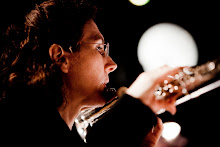When writing for the flute and voice there are several things to take into consideration.
The first may be: where to notate the voice line?
For solo pieces: if you have an extended or complicated voice line it is customary and practical to use a separate staff below that of the flute line. On the other hand, for short simple passages, I prefer to have the voice pitches on the same line as the flute.
In the context of an ensemble piece, I would use the same guidelines as above, and please be sure to notate the voice line below the flute. As a general rule, it is best to leave free space above the staff for an ensemble player to mark in beats, que notes, or remarks from the conductor.
Another consideration is the distortion produced by the simultaneous use of the voice and flute. The use of the voice (as most of you know, I am sure) in conjunction with the flute greatly distorts not only the flute sound, but the voice line and any text that you may want to set. Because of this distortion, getting a true polyphony going can also be tricky if you have a complicated passage. In this case, if you want true polyphony, use two instruments. I prefer the use of the voice and flute as a coloristic element, rather than using it as an attempt to create polyphony.
If you want to set text that is understandable to the audience, it is not advisable to ask the flutist to play at the same time as speaking. A better technique would be to have the flutist speak or sing the words using the resonance of the flute only. Beware of text with nasal vowels, these produce no resonance on the flute.
Speaking or singing directly into the flute (with the embouchure hole completely closed) is another option. This of course produces a muffled effect; however, rapid key action will interrupt the muffling and create an acoustic "panning". This effect can be heard at the beginning of George Crumb's Voice of the Whale
Some examples of the most effective uses of flute and voice are Noa Noa by Kaija Saariaho for flute and live electronics, and Toru Takemitsu's Voice .
When using a vocal line with the alto flute, there is the option of transposing the vocal line or writing it at pitch. Personally, I prefer having the voice line transposed with the alto flute. Since I have only a relative sense of pitch, it makes sense for me to have the voice always referring to the alto flute pitch; although, if the flutist for whom you are writing has a strong sense of perfect pitch, it would be better to write the voice part at pitch.
Wednesday, February 17, 2010
Subscribe to:
Post Comments (Atom)


One more important thing to take into consideration is at which *pitch* the voice is actually meant to be - transposing by an octave will completely alter the timbre. The flute generally sounds lower than it actually is (i.e. it can be a challenge for a male voice to sing at the flute's real pitch…). I have noted some uncertainty with regards to this aspect in some composers…
ReplyDeleteThanks very much for the XY perspective! And you are completely right about the timbre/octave connection.
ReplyDeleteAlto and bass flutes match the range of the human voice much better than the C flute.
As a professional singer, what this teacher says really makes a lot of sense. I hope that young people read and understand it. Singing is a wonderful thing and can be a wonderful career. singing for beginners
ReplyDelete